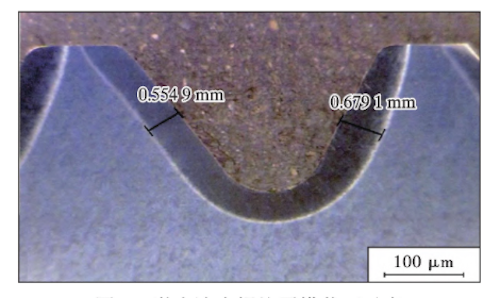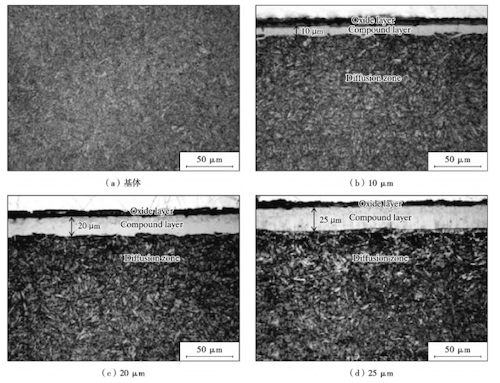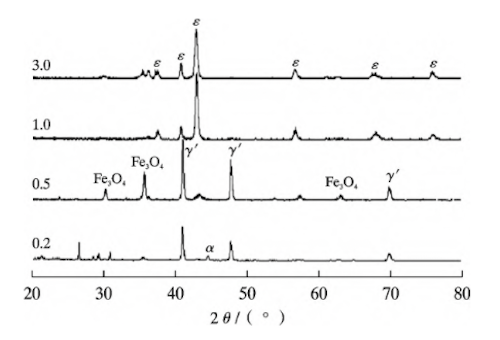Threaded connections are critical components in oil well pipes, used to connect oil casings, drilling tools, and other equipment for the transmission of mechanical power. Threaded connection failure is the most common mode of failure in oil well pipes, and the thread surface condition is crucial for the safety and reliability of these connections. This paper reviews current surface treatment for oil well pipes, focusing on the importance of thread surface treatment and the role of heat treatment in enhancing thread performance.
Threaded connections are a common method for joining mechanical components in the oil and gas industry, especially in pipelines and drilling tools. During operation, the contact area between the joint threads is large, with complex stress distribution and significant concentrations of stress. Connection failure is a leading cause of issues in oil pipelines, with problems such as thread sticking, slippage, and sealing failures causing significant economic losses. With the rapid advancement of the manufacturing sector, the performance of oilfield equipment has improved, and the use of high-torque, large-diameter drill pipes has increased. However, the higher torque in connections has greatly increased the likelihood of thread friction and wear, directly impacting the service life of threaded joints.
Material failures often originate at the surface, where fatigue, corrosion, and wear are highly influenced by the surface structure and performance. Optimizing material surface properties can significantly improve their performance. Copper plating and phosphating are widely used surface treatment methods for oil well pipe threads. These processes create uniform surface layers that prevent direct contact between the threads and external elements, reducing corrosion and oxidation. When combined with thread lubricants, these treatments help reduce wear and friction during thread make-up and break-out. However, both phosphating and copper plating require multiple stages of cleaning and washing, generating large volumes of wastewater. Additionally, thread lubricants often contain heavy metals such as zinc, lead, and copper, and the waste generated during cleaning is contaminated with these heavy metals and organic compounds, complicating waste treatment and disposal.
As oil extraction challenges grow, so do the demands on the performance, corrosion resistance, and mechanical properties of oil well pipes. As a result, there is growing attention on the anti-galling performance of threaded connections. Traditional processes, such as copper plating and phosphating, have not kept pace with advancements in modern technologies, highlighting the need for new surface treatment for oil well pipe threads. Proper surface treatment not only extends the service life of these pipes but also optimizes their performance in different operational environments by modifying the material’s surface structure. In recent years, stricter environmental regulations have increased pressure to reduce pollution in the surface treatment industry. To comply with the "Law of the People's Republic of China on the Prevention and Control of Environmental Pollution by Solid Waste," the Ministry of Industry and Information Technology issued Document No. 25 in late 2021. This document mandates the phase-out of outdated production processes and equipment, including phosphating for drilling and production tool joints, by December 31, 2023. Therefore, it is essential to improve surface treatment processes for oil drilling equipment in an environmentally sustainable manner, reducing pollution while maintaining performance and enhancing the anti-galling properties of oil pipe threads. This paper reviews recent advancements in surface treatment technologies for oil well pipe threads and explores promising methods, including heat treatment and lubricating coatings.
The copper plating process is complex, costly, and inefficient, leading to a decline in its use. Phosphating is currently the most effective method for treating drilling tool threads. Researchers have recently developed a more environmentally friendly phosphating process that replaces the traditional open-tank method. This process integrates cleaning, pickling, and phosphating into a closed-loop system, using organic solvents and polymers to adsorb impurities, reduce wastewater, and improve sustainability. Zhengyong Duan et al. designed a fully closed-loop phosphating system. Zhang et al. developed automated, environmentally friendly equipment for phosphating the threads of oil drill collar couplings. Figure 1 illustrates the difference between the traditional open phosphating process and the closed-loop process. Figure 1b shows fully enclosed equipment, which, unlike the open phosphating tank, allows for the recycling of solutions used in descaling, phosphating, and passivation, reducing the amount of phosphating solution required and minimizing toxic emissions. The phosphating layer produced meets the required specifications. Environmentally friendly phosphating equipment is being implemented in the pre-treatment of coatings in international coating and decoration industries.

Figure 1 Open phosphating process and closed phosphating process
Heat treatment is a well-established technique for modifying the structure and enhancing the performance of engineering materials. Surface heat treatment refines the material's surface, increases its hardness, and improves its fatigue resistance. Common heat treatment methods are isothermal quenching, vacuum heat treatment, and deformation heat treatment. Heat treatment of thread surfaces addresses challenges related to complex geometries and the need for precise modification of contact surfaces. It enables precise control over the transformation of the material's microstructure, significantly improving surface hardness, fatigue resistance, and anti-galling properties.
Lasers possess high monochromaticity, coherence, and energy density. Using lasers for surface treatment improves material properties without altering the internal structure of the base material. Laser heat treatment uses high-energy laser beams to rapidly scan the material surface, inducing a phase transformation in the irradiated area without melting the material, resulting in a martensitic hardened layer. The degree of supercooling and superheating during laser quenching is considerable, enhancing the material's hardness. After quenching, the hardened layer exhibits extremely fine grains and high dislocation density. Compressive stress is generated on the surface, which improves wear, corrosion, and fatigue resistance, as well as oxidation resistance.
Following laser heat treatment, Jianying Liu et al. observed significant improvements in the surface hardness and tensile strength of mining oil pipe threads. The hardened layer exhibited a fine martensitic structure with a grain size of 13.0, and its volume was greater than that of other microstructures. The hardened thread layer was under compressive stress, which enhanced fatigue resistance. The joint underwent 10 make-up and break-out tests at the specified maximum torque without any sticking. Additionally, multiple make-up and break-out tests were conducted at 1.6 and 2.0 times the specified maximum torque, with no significant sticking.
Pengfei Ge performed laser quenching on the threads of a 37CrMnMo 5½ drill pipe joint. To improve laser heat absorption on the thread surface, a light-absorbing coating was applied after turning. The cross-section of the thread after laser treatment is shown in Figure 2.

Figure 2 Cross-Section of Laser-Quenched Thread Roots
After treatment, the surface hardness of the thread was approximately 680 HV, with a quenching layer thickness of around 0.6 mm. The joint's average fatigue life reached 2.884×105 cycles, and wear resistance was significantly improved. By adjusting the spray range of the light-absorbing coating on the thread surface, the laser energy absorbed by the material can be controlled, ensuring a uniform quenching layer on both the side and bottom of the threads. The flat threads of the oil pipe maintain a consistent distance from the laser emission port during quenching, ensuring uniform quenching of the threads. This method has been successfully applied in several domestic oil fields, demonstrating effective anti-sticking properties.
Laser quenching of the threads reduces surface wear and enhances anti-sticking properties. However, precise control of movement parameters in all three dimensions is critical. Without precise control, uneven quenching layer thickness can result, leading to thread stress concentration and negatively affecting joint fatigue performance. The metallographic structure of steel after laser quenching is primarily martensite, an unstable phase known for its hardness, brittleness, and high susceptibility to cracking.
Chemical heat treatment is a process that uses chemical reactions to modify the chemical composition and microstructure of a material's surface, thereby enhancing its properties. Common chemical heat treatment methods include nitriding, carburizing, boronizing, and metalizing. Nitriding is one of the most commonly used surface modification processes, aimed at improving surface hardness, fatigue strength, wear resistance, and corrosion resistance in components like gears, molds, and drilling tools. The thread surface infiltration process involves the absorption of nitrogen atoms by the steel surface, forming a nitrided layer typically 0.2–0.3 mm thick, with a hardness exceeding 800 HV. This treatment significantly improves resistance to adhesive and abrasive wear, as well as enhancing surface corrosion resistance. The nitrided microstructure is shown in Figure 3.

Figure 3 Microstructure of maxrix and the different nitriding layer thickness
Nitriding methods include gas nitriding, ion nitriding, rare-earth co-infiltration, surface nano-nitriding, and others. Selecting the appropriate nitriding method based on chemical requirements can enhance the performance and extend the service life of nitrided components. Jianhong Xiao applied pulse vacuum nitriding to oil pipe surfaces, resulting in the formation of iron-nitrogen compounds and a nitrogen-enriched austenitic quenching layer. After nitriding, no sticking was observed after 9 cycles of make-up and break-out. The oil pipe's corrosion resistance was significantly improved, and the treatment demonstrated excellent performance in field tests.
Wenhua Xu et al. studied the friction and wear properties of nitrided 37GrMnMo, a commonly used drill pipe material. They found that as nitrogen potential increased, the surface structure changed from α-Fe to γ phase, and eventually to a mixed γ phase, as shown in Figure 4. Once the γ phase formed, it continued to grow. At nitrogen potentials of 0.2 and 0.5, a uniform single-phase layer was produced, offering optimal wear resistance. Chengmei Cui performed ion nitriding on 42CrMo steel and observed that as nitriding temperature increased, the compound layer thickness initially increased and then decreased, peaking at 580°C. The thickness of the individual layers remained stable. As nitriding time increased, both the compound and total nitriding layer thicknesses increased.

Figure 4 XRD spectra of nitrided samples with different nitrogen potentials
Tungsten alloy coatings offer exceptional properties, including a high melting point, excellent hardness, superior corrosion resistance, and outstanding wear resistance. Applying a nickel-tungsten alloy coating to the surface of oil drilling components improves wear and corrosion resistance, thereby extending their service life. Xining Lu et al. studied the impact of nickel-tungsten alloy coatings on the thread performance of oil drill pipe joints and found that the coating's hardness was 2 to 3 times higher than that of the substrate. However, the coating exhibited poor plastic deformation, leading to a significant reduction in fatigue life, which was only about 20% of that of the untreated specimens. The coating thickness on the joint threads was uneven: the top layer exceeded 50 μm, while the bottom layer was only 10 μm. This caused severe sticking after just three consecutive make-up and break-out cycles. Zhonghua Song et al. electroplated a tungsten-nickel alloy onto the inner wall of the oil pipe and found that the coating exhibited excellent corrosion resistance without affecting the sulfide stress cracking resistance of the substrate. This coating is suitable for specialized oil pipe joints and offers excellent anti-galling properties without compromising sealing performance.




